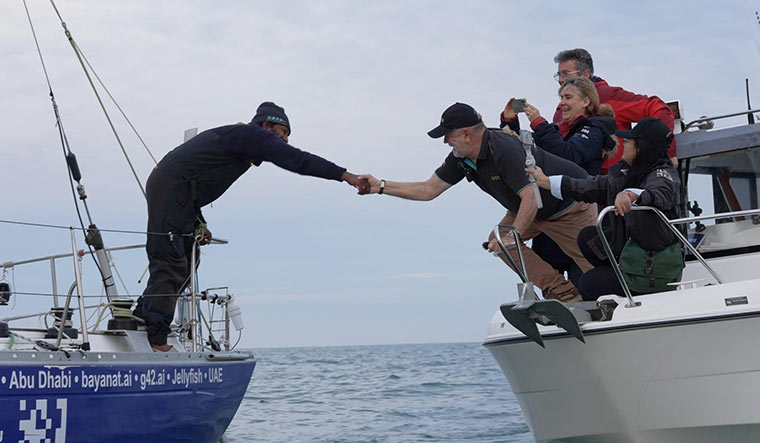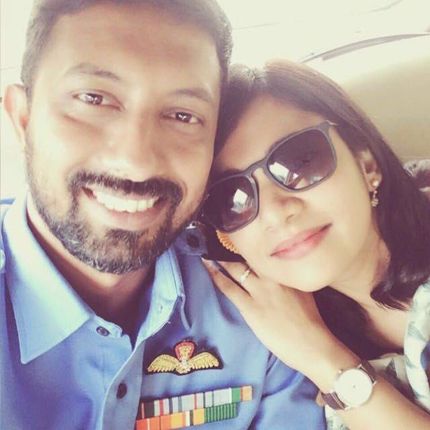Commander Abhilash Tomy (CAT) told me this four years ago: “I need to close an unfinished business.” And the cool CAT closed it this April. He had abandoned Golden Globe Race 2018 after a brush with death in the southern Indian Ocean. Only a daredevil would race again in the world’s most challenging ocean adventure.
Sixteen world-class sailors attempted the nonstop solo Golden Globe Race 2022, the longest yachting event in the world. They sailed out of the French coastal town of Les Sables-d’Olonne on September 4, 2022. Nearly eight months later, the intrepid South African sailor, Kirsten Neuschäfer, made it back to the base in the early hours of April 27.
CAT returned a day later, on April 29, close behind her. It was 236 days of neck-and-neck sailing, and until the end, neither of them knew their ranking while circumnavigating the globe. Michael Guggenberger from Austria is likely to finish number three at least ten days later. All three deserve the world’s admiration.
The others who are still in the race will finish in the Chichester Class―a class lower than GGR, as they would have made a stop for supplies and repairs, or broken the seal on their GPS devices. While winning matters, staying safe till the very end is of paramount importance in this adventure across three oceans.
CAT knew it well. As part of the Indian Navy’s second Sagar Parikrama initiative, he circumnavigated the globe in 151 days on board the INSV Mhadei in 2013. It was also a nonstop solo. He then had the benefit of a satellite navigation system. President Pranab Mukherjee received CAT at the Gateway of India to mark that historic Mumbai to Mumbai voyage.
The first Golden Globe Race in 1968 had strict specifications and a cash prize of £5,000 (Rs5 lakh now). The winner, Sir Robin Knox-Johnston from England, completed it in 312 days. All aspects of the Golden Globe Race remain unchanged. To mark its 50th year, the Golden Globe Race was replicated in 2018. CAT was holding the third position on Thuriya in that race, when he fell off a 30ft-high mast while attempting to repair it during a storm. Almost crippled, he lay on the deck for nearly three days with four damaged vertebrae. Rescued and taken to the Army Hospital in Delhi, CAT had titanium rods fused into his spine. After months of rehabilitation, CAT began to walk, determined to attempt the race again.
To attend to the “unfinished business”, CAT took early retirement in 2019 from the Indian Navy, where he was a reconnaissance pilot. When he was preparing the Rustler 36 yacht named the Bayanat, I asked him what his feeling would be if he spotted the abandoned Thuriya still floating in the Indian Ocean. He replied, “Nobody would like to meet his ex-girlfriend on his honeymoon.”
A few weeks ago, he remarked that it would be an eight-month voyage on the Bayanat, and with a month more, the gestation period would have been completed to have a baby!
GGR uses technology that was available in 1968, and allows no access to modern navigation support, such as internet or GPS. The sailors rely on celestial or sextant navigation supported by paper charts. Weather forecasts can be had only through high-frequency amateur radio, weather facsimile or weatherfax, and general weather broadcasts on radio.
A challenge to any sailor is the rounding of Cape Horn, at the southern tip of Chile. The Pacific and the Atlantic Ocean meet here, and the sea is quite treacherous. At Point Nemo, an oceanic location in the South Pacific, whichever way you look, the closest land is 2,500km away.
Bayanat did not carry a weatherfax, though permitted in the race. It is a receiver that gathers critical sea weather conditions but only in certain parts of the ocean. Though this was on CAT’s wish list, he decided to work out his own weather charts. The weatherfax costs $10,000 (Rs8,20,000) and he decided not to buy one as he needed to fix his boat after an accident during the qualification passage from Spain to France.
The mishap happened due to the negligence of a boy who was supporting CAT to get Bayanat prepared for the race. The lad who was engrossed in a book―Sir Robin’s A World of My Own, no less―heard a thud and it was a messy one. It shook up CAT, but he bounced back to get on with the job.
Though not a sailing aficionado, I was in the WhatsApp group that followed the race. Updates from Don McIntyre, the race chairperson, were educative. CAT faced unceasing waves of challenges in the three oceans. He had a broken wind-pilot, a mechanical self-steering system. With no material to repair it, he created the system’s wind vane out of the chart table. When even that broke, the toilet door came to his rescue. With his humour intact, he remarked, “Now I lack privacy, no bathroom door!”
In the last 10 days, a runner that supported the mast’s angles for various wind conditions needed to be fixed. CAT collected rainwater in his sails for cooking. His power system had failed, but solar energy kept the Bayanat going. So, too, did the radio. On a calm day in the Atlantic, he wrapped a rope around his waist and jumped into the ocean to clean barnacles from the hull. Fortunately, there were not too many, he remarked.
CAT called on the day he returned. He said, “It has been a great voyage and I am longing to get back home soon. I need to hand over the Bayanat to my sponsors before that. They have plans to place it in a museum.” The UAE-flagged boat was sponsored by the AI solutions company Bayanat of Abu Dhabi.
CAT and Bayanat made a perfect pair, trusting and supporting each other. A unique love story that would end with the voyage, but a bond that will last forever for the daredevil who knew every aspect of the boat. CAT’s wife, Urmi, too, is familiar with the inner secrets of the boat, she having respected and supported his desire to complete “the unfinished business”. The two boys, Vedant and Abhraneil, have been pining for CAT. Urmi heroically handled the home front, never forgetting the uncertainties in the oceans. The Thuriya episode popped up often in her mind. “Safe voyage was my priority,” she told me. “Abhilash has done the big ocean racing earlier, too, and I wanted him to enjoy this race to his satisfaction. And he finished it.” Full marks to Urmi.
CAT’s parents, Valsamma and Commander (retd) V.C. Tomy, lead a retired life 25km out of Kochi. “We wanted Abhilash to finish the race safely and happily,” said the father. “Otherwise, he might be at it again.”
For CAT it was a nail-biting finale to 30,246 nautical miles (55,000km) of precarious ocean adventure! Only a rare breed with a unique brain will ever attempt a race with multiple challenges. An eight-month-long solo ocean race with high endurance tests can be done only by a daring few who have full control of their mind, body, and spirit. And the cool CAT from India did it.
Jacob Mathew is publisher of THE WEEK and managing editor of the Malayala Manorama.



